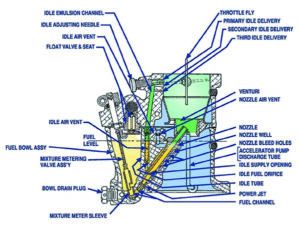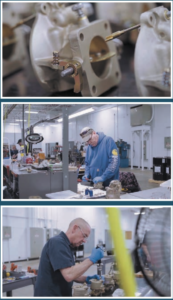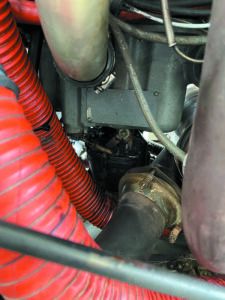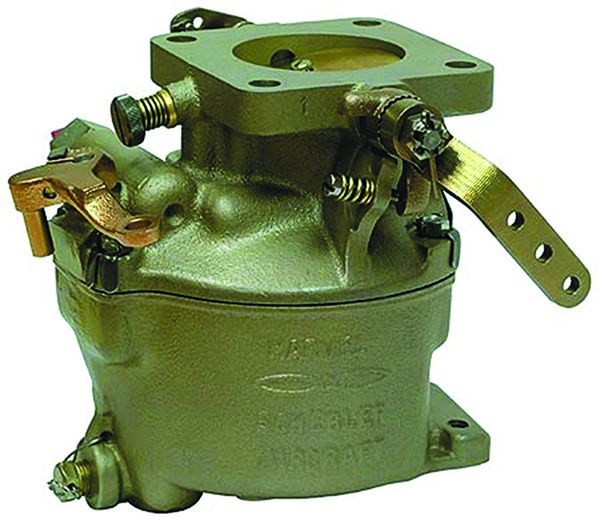Let’s see—we’ve got avgas in the tanks and air containing oxygen all around us. Somehow that air and avgas have to combine in a roughly 15 to 1 ratio—by weight—in the engine’s cylinders. Then they can do their suck, squeeze, bang and blow thing to make the prop go whirling around. Enter the humble carburetor, the device that for over 100 years has been combining a gas and a liquid to create the explosive mixture in aero engines that lets us do that cool pilot stuff we do.
Other than pulling the carb heat knob from “off” to “on,” we suspect that the last time you thought about your carburetor was when the engine stumbled a bit as you added power, or your shop asked if you wanted it overhauled when you sent your engine out for its overhaul.
Let’s take a few minutes to look at how an aircraft engine carburetor works, what can go wrong with it, how to troubleshoot problems and when it’s time for an overhaul.
FUEL METERING 101

The creation of a combustible charge of avgas and oxygen is called metering. To start with, for the mixture to burn it must have an air-to-fuel ratio of between 8-to-1 and 18-to-1 by weight. Weight is used because the volume of air varies significantly with temperature and pressure. A mixture less than 8-to-1 is too rich to burn—avgas without air is just a puddle with a lot of potential energy. A mixture greater than 18-to-1 is too lean to burn.
The ideal mixture is 15-to-1—stoichiometric—all the fuel and all of the oxygen in the air will be completely used in the combustion process. It produces the highest combustion temperatures because the proportion of heat released to a mass of air and fuel is the greatest. When we’re flying, we use mixtures that are pretty close to 15-to-1.
While we’re talking about an air-to-fuel ratio, we’ll note that 21 percent of air by volume is oxygen, the gas that helps the explosion in the cylinders happen and is consumed with it. Nitrogen, an inert gas, makes up 78 percent of air and remains aloof from the combustion process but then gets involved—with the other 1 percent of gases in air and the gaseous products of combustion—by absorbing the heat and expanding and driving the piston toward the crankshaft.
Where the process of fuel metering gets interesting is keeping the air-fuel ratio constant—or nearly so—at all power settings and altitudes without creating such a workload on the pilot that flying the airplane becomes secondary.
In addition, the fuel metering system has to atomize and distribute the fuel into the air and distribute the mixture to the cylinders uniformly—well, pretty much uniformly. It’s a carburetor, not fuel injection.
COMBINE WITH CARBON
“Carburetor” has its antecedents in France, coming from the verb carburer—to combine with carbon. A carburetor increases the amount of carbon in air by combining it with gasoline—a hydrocarbon.
The first carburetors were developed in the 1860s and, not surprisingly, weren’t particularly effective unless the engine was operating at a constant power. That was the state of affairs until the German genius Wilhelm Maybach invented a mechanism involving a float and needle valve some 30 years later—and it’s still in use.
The company most known for carburetors for horizontally opposed aircraft engines, now Marvel-Schebler Aircraft Carburetors LLC (www.msacarbs.com), evolved from the Indy racing world of the 19-teens, and has gone through a series of ownership changes, but is still making aircraft carburetors. Because it is ubiquitous in the general aviation world, we’ll focus on its line of aircraft carburetors.
IT’S THE VENTURI
To measure the airflow through the engine’s induction system and use the measurement to regulate the amount of fuel discharged into the airstream the carb uses a venturi. That relies on a basic law of physics everyone in aviation is familiar with—as the velocity of a gas or liquid increases, the pressure decreases.
The pressure drop is proportional to the velocity and is, therefore, a measure of the airflow. The carb’s operation depends on the differential pressure between the venturi inlet and the venturi throat.
The airflow through the carburetor—and its venturi—results from the suction generated by each of the engine’s pistons as they move toward the crankshaft during the intake stroke. Atmospheric pressure of the air upstream of the carburetor pushes the air through the carb to the engine cylinders.
To control the airflow toward the engine a throttle valve is installed in the carb downstream from the venturi. The valve is connected to the throttle in the cockpit by a mechanical linkage. Opening the throttle valve by pushing the throttle forward admits more air to the engine and the carburetor automatically provides enough additional fuel to maintain the appropriate air-to-fuel ratio in the cylinders.
Fuel arrives at the carburetor via gravity or a fuel pump; it enters and is initially stored in a fuel bowl or float chamber. A float or floats attached to a needle valve let fuel into the bowl when it is needed. Fuel is sucked from the bowl and through the fuel nozzle by the low-pressure air in the carburetor venturi.
CARBURETOR SYSTEMS
We’ll do a quick rundown of the six systems common to float carburetors—the type most often found with horizontally opposed aircraft engines.
1) Float Mechanism. The float chamber is designed to provide a nearly constant level of fuel to the main discharge nozzle in the lowest pressure portion of the venturi. The level is a fraction of an inch below the openings in the nozzle—so there is no leakage into the venturi when the engine is shut down.
A float-operated needle valve keeps the fuel level constant in the chamber. One of the longtime problems with carburetors as they aged was the float losing its buoyancy and sinking, causing the air/fuel mixture to become way too rich. Some years ago Marvel-Schebler developed an solid epoxy float that apparently will not sink.
With the engine running, the float assumes a position that keeps the needle valve open sufficiently to supply the required amount of fuel to the fuel nozzle and keep the fuel level in the float chamber constant.
2) Main Metering System. The main metering system supplies fuel to the engine at all speeds other than idle. It is made up of the venturi, a main metering jet, main discharge nozzle, passageway to the idling system and the throttle valve. This system gets fuel to the fuel nozzle at the appropriate rate for the power setting and the fuel is ejected from the nozzle in a fine spray that quickly vaporizes in the air.
3) Idling System. When the throttle is pulled back to idle the air velocity through the venturi is so low that it cannot pull fuel from the float chamber via the fuel nozzle. Nevertheless, low pressure exists on the engine side of the throttle valve, so a fuel passageway runs from the float chamber to a point near the edge of the throttle valve. The opening is the idling jet. A separate air bleed known as the idle air bleed is included as part of the idling system.
4) Mixture Control System. Because the low pressure area created by the venturi is dependent on air velocity rather than density and because air is less dense with altitude, something has to compensate for the fact that the venturi draws the same volume of fuel through the fuel nozzle at high altitude as it does at low so that the mixture is not too rich.
A manual mixture control progressively restricts the flow of fuel to the fuel nozzle as the control is moved toward the lean position.
5) Accelerating System. If the throttle is opened quickly the sudden rush of air through the venturi increases demand for fuel from the float chamber. However, there can be a lag in fuel supply causing a lean mixture and engine hesitation or stumbling. Some carbs are equipped with an accelerator pump operated through a linkage to the throttle control that puts additional fuel into the main metering system when the throttle is moved rapidly.
6) Economizer System. A number of carburetors have an economizer system that provides a richer mixture to the engine at high power settings, primarily for cooling and to prevent detonation.

We started out our conversation with Marvel-Schebler’s Manager of Product Line Services, Mark Keeney Jr., talking about carburetor overhauls and rebuilds. Marvel-Schebler is not only the OEM supplier of carburetors to aircraft engine manufacturers, it has a substantial overhaul and rebuild business, primarily through a network of distributors.
Keeney reviewed Marvel-Schebler’s Service Bulletin calling for carburetor overhaul at engine overhaul or 10 years in service, whichever comes first. He emphasized the detrimental effect on carbs that aren’t being flown: “Gaskets and O rings dry out. If the airplane is parked outside, it’s not unusual to get water in the fuel system which can lead to corrosion. Issues with moving parts develop as well.”
Turnaround time for an overhaul is on the order of two weeks, according to Keeney. We looked at the websites for various service facilities—many of which then send the carb to Marvel-Schebler for work (the photos on this page were taken at Marvel-Schebler, showing buildup and overhaul)—and noted that overhaul prices varied with the size of the carburetor, but were in the $700 to $800 range. To save time, for a small additional sum an owner can buy an “overhaul exchange” carburetor off the shelf although it does require sending in the old carburetor. That beats approximately $2000 for a new one.
Keeney told us that an overhaul returns the carburetor to at least factory wear limits, has all of the service bulletins and airworthiness directives performed and includes new gaskets and hardware that is either new or replated and upgrades floats to the current, solid epoxy model.
A rebuild goes above and beyond an overhaul—at a slightly higher price. It generally includes more new parts as it takes the carburetor to factory new tolerances.
Keeney agreed with the remarks that we’d heard from A&Ps regarding carburetor health—do the routine maintenance, make sure the air and fuel filters are clean, adjust the idle mixture periodically if you live in an area of large temperature swings between summer and winter and recognize that with age, hoses break down and can put debris into the carburetor where it can do things such as block the accelerator pump open.
“Owners tell me that they are always careful to drain the gasculator and that it’s always clean. But they forget that there is a hose downstream from the gasculator to the carb and when it gets old, it will deteriorate.”
As our conversation continued, Keeney discussed issues owners are likely to run into in service and pointed us to the troubleshooting information contained on Marvel-Schebler’s website (www.msacarbs.com). We spent some time looking at it and saw that it covered numerous service problems we’d heard described by owners. We think that it’s a little-known resource to both owners and technicians.
In addition, Keeney stressed simply calling the customer service line, 855-672-2272, whether you are a mechanic or an owner. “That’s my job. I want to talk with you about any engine issues you have that may be related to the carburetor. I should be able to help you with troubleshooting, which can save you money in the shop.”
CARBS IN THE REAL WORLD
Our conversations with aircraft owners, maintenance facilities and personnel at Marvel-Schebler gave us consistent feedback that with routine maintenance and inspection, a carburetor should last until it’s time to overhaul the engine. That being said, the worst enemy of a carb is sitting, so calendar time may be more important than engine time if the airplane is flown infrequently.
Bottom line on a modern carburetor, plan on overhauling or rebuilding it when you send out the engine for overhaul. Marvel-Schebler also recommends that its carburetors be overhauled or rebuilt after 10 years in service. Service Bulletin MSA-3 dated Nov. 18, 1991, gives more detail.
We spoke with Derek DeRuiter, proprietor of Northwoods Aviation in Cadillac, Michigan, about his experience in maintaining carburetors. He told us that he routinely observes carbs making it to engine TBO without any problem so long as they are inspected carefully as part of annual and 100-hour inspections. That includes starting with observing overall condition and checking for leaks—and stains indicating the presence of leaks.
Not surprisingly, leaks must be repaired immediately. DeRuiter said that if there is going to be a leak it will most likely be where the bowl attaches to the body. Leaks are more likely in engines that have been sitting as gaskets dry up and hoses can become brittle.
To ensure that the engine will develop full power as we’ll as idle, the throttle and mixture controls must move smoothly through their full range of motion and the connections should be in good shape—watch for jammed rod ends and bolts as we’ll as sloppy linkages.
IDLE MIXTURE

Idle mixture and roughness are frequent causes of owner complaint. It is not unusual for the idle mixture to have to be tweaked as the weather changes from cold to hot—and it starts to run rich—or the converse. To check it, watch for a slight increase in engine RPM when shutting the engine off with the mixture control. It should be between 25 and 50 RPM.
In addition, idle RPM should be in the 650 to 750 range. The engine should not stop running when the carb heat is pulled to idle.
Mark Keeney Jr. of Marvel-Schebler told us that a leaking primer system or cracked primer lines can be the hidden culprit behind carburetor problems. Leaks can be responsible for an inability to shut off the engine with the mixture control as we’ll as an overly rich mixture as a primer leak bypasses the carb.
The engine stumbling on acceleration can also be due to a primer system leak.
In our conversation, Keeney interjected a comment that a pilot should know the conditions that are conducive to icing—and that they include surprisingly warm temperatures.
In addition, you can get it while taxiing. We fully agree. If you’ve got a carburetor, know the risk of carb ice and how to deal with it. Don’t be afraid to use the carb heat knob early and often.
CONCLUSION
Over the years we’ve watched as carburetor problems have diminished as the manufacturers have steadily upgraded their products. However, to assure yours will last to engine TBO, basic, routine maintenance is a must and you should fly your airplane regularly.


